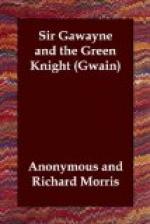But while our author has borrowed many of the details of his story from the “Roman de Perceval” by Chrestien de Troyes, he has made the narrative more attractive by the introduction of several original and highly interesting passages which throw light on the manners and amusements of our ancestors.
The following elaborate descriptions are well deserving of especial notice:—
I. The mode of completely arming a knight (ll. 568-589).
II. The hunting and breaking the deer (ll. 1126-1359).
III. The hunting and unlacing the wild boar (ll. 1412-1614).
IV. A fox hunt (ll. 1675-1921).
The following is an outline of the story of Gawayne’s adventures, more or less in the words of the writer himself:—
Arthur, the greatest of Britain’s kings, holds the Christmas festival at Camelot, surrounded by the celebrated knights of the Round Table, noble lords, the most renowned under heaven, and ladies the loveliest that ever had life (ll. 37-57). This noble company celebrate the New Year by a religious service, by the bestowal of gifts, and the most joyous mirth. Lords and ladies take their seats at the table—Queen Guenever, the grey-eyed, gaily dressed, sits at the dais, the high table, or table of state, where too sat Gawayne and Ywain together with other worthies of the Round Table (ll. 58-84, 107-115). Arthur, in mood as joyful as a child, his blood young and his brain wild, declares that he will not eat nor sit long at the table until some adventurous thing, some uncouth tale, some great marvel, or some encounter of arms has occurred to mark the return of the New Year (ll. 85-106).
The first course was announced
with cracking of trumpets, with the
noise of nakers and noble
pipes.
“Each two
had dishes twelve,
Good beer and
bright wine both.”
Scarcely was the first course served when another noise than that of music was heard. There rushes in at the hall-door a knight of gigantic stature—the greatest on earth—in measure high. He was clothed entirely in green, and rode upon a green foal (ll. 116-178). Fair wavy hair fell about the shoulders of the Green Knight, and a great beard like a bush hung upon his breast (ll. 179-202).
The knight carried no helmet, shield, or spear, but in one hand a holly bough, and in the other an axe “huge and unmeet,” the edge of which was as keen as a sharp razor (ll. 203-220). Thus arrayed, the Green Knight enters the hall without saluting any one. The first word that he uttered was, “Where is the govenour of this gang? gladly would I see him and with himself speak reason.” To the knights he cast his eye, looking for the most renowned. Much did the noble assembly marvel to see a man and a horse of such a hue, green as the grass. Even greener they seemed than green enamel on bright gold. Many marvels had they seen, but none such as this. They were afraid to answer, but sat stone-still in a dead silence, as if overpowered by sleep;
“Not all from fear, but some for courtesy” (ll. 221-249).




